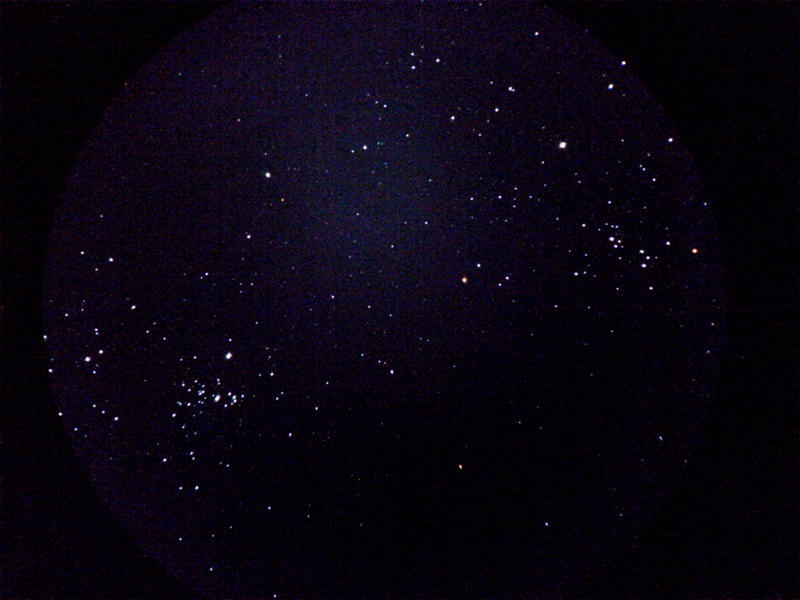JMI MicroFocus troubleshooting;
Imaging: ISS, Moon, Double Cluster
Posted: 25 October 2015
On my last report I mentioned having an issue with my JMI MicroFocus fine-focus knob. It would not reliably change the focus. Saturday morning, 24 October 2015, I spent about an hour troubleshooting the issue. I removed the JMI MicroFocus from the telescope and checked the operation of the coarse and fine focus knobs. They both operated properly. I reattached the MicroFocus to the telescope focus knob and began experimenting with placement of the MicroFocus on its adapter collar. If the separation was too small the fine focus knob would stop working, and sometimes even the coarse focus knob would stop rotating the telescope focus knob. The same thing happened if the separation was too great. After spending about an hour I finally determined that a separation of 4mm was what was needed for the fine (and coarse) focus to work properly. Apparently over the past four years there had been some movement that changed this distance as I used the MicroFocus. I know I had fiddled with the separation when I discovered a shift in the MicroFocus several sessions ago. Hopefully I now have things back to normal.
Clouds began appearing in the western sky about 90 minutes before sunset on Saturday from another low pressure system approaching the area.
|
Open: Saturday, 24 October 2015, 1703 MST Temperature: 85°F |
Session: 870 Conditions: Mostly clear, clouds in west |
First, I updated the ISS TLE for the evening's pass, which would occur about 30 minutes after sunset. I then mounted the D7200 DSLR at the 8" LX200-ACF prime focus + 2X PowerMate. I then began waiting for the waxing gibbous Moon to rise above a tree to the southeast. I would use the Moon as a focus target since no stars were yet visible. 1742 MST: sunset. Slewed to the Moon and checked finderscope alignment; OK. 1747 MST: 20 minutes before the start of the ISS pass. Focused on the Moon and locked the telescope focus. I was now ready for the ISS pass. The clouds in the west would not be a factor, although the bright twilight sky might be.
After the pass started it took a couple of minutes to acquire the ISS, first with the naked eye and then in the finderscope (initial telescope pointing was a little off). Once I got the ISS centered in the finderscope initial tracking was pretty good. But as the ISS approached the North Celestial Pole (NCP) tracking went berserk (as it usually does when the ISS is near the NCP). I lost the ISS in the telescope for the middle portion of the pass and did not acquire it again until the ISS was into the tree to the southeast. There were a few good frames in the HD video, 1.3X crop factor, 60 fps, 1/1250sec, ISO 5000, but most were very similar. Here are two views of the ISS as acquired Saturday evening:

Not a great pass and certainly not my best images of the ISS.
1820 MST: slewed to the Moon and took the following images, 1/400sec, 1/500sec, and 1/400sec (respectively), ISO 1600:



Removed the Televue 2X PowerMate for this prime focus image of the Moon, 1/400sec, ISO 800:

Removed the DSLR from the telescope and did some lunar observing, 83X. Checked the JMI MicroFocus; it worked perfectly.
Slewed to the star Altair and did an AutoStar SYNC. I had likely slightly messed up the mount position during the daytime when I was troubleshooting the MicroFocus so I figured this realignment would correct any pointing errors for this night.
Slewed to the Double Cluster and did some test images using NightCap Pro on the iPhone 5s (mounted afocally 77X using the Orion SteadyPix). This image was taken with Long Exposure, Light Boost, ISO 8000, 1/2sec, 10 second exposure:

That's a pretty good image of the Double Cluster considering the bright moonlit sky. This is how a live view of the Double Cluster appeared on the Apple Watch using NightCap Pro:

Slewed to the Moon for this iPhone 5s photo (Camera app), afocal 77X:

|
Close: Saturday, 24 October 2015, 1921 MST Temperature: 65°F |
Session Length: 2h 18m Conditions: Mostly clear |
Comments are welcome using Email. If you are on Twitter you can use the button below to tweet this report to your followers. Thanks.
Cassiopeia Observatory Home Page
Copyright ©2015 Michael L. Weasner / mweasner@me.com
URL = http://www.weasner.com/co/Reports/2015/10/25/index.html
